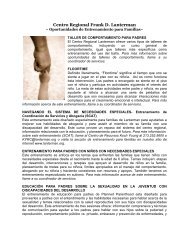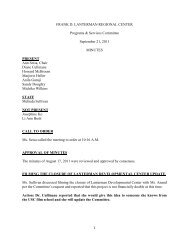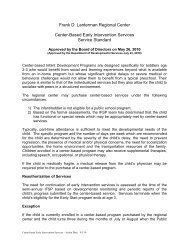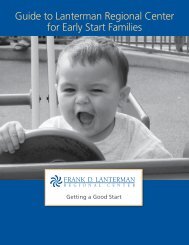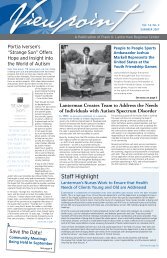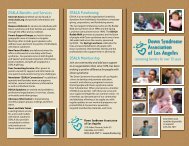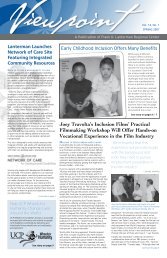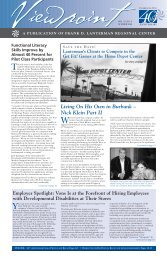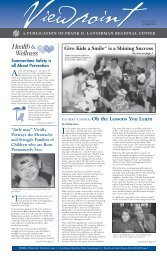40th History Brochure-r2 - Frank D. Lanterman Regional Center
40th History Brochure-r2 - Frank D. Lanterman Regional Center
40th History Brochure-r2 - Frank D. Lanterman Regional Center
Create successful ePaper yourself
Turn your PDF publications into a flip-book with our unique Google optimized e-Paper software.
Reaffirming theCommitment...Realizingthe Vision40 thA N N I V E R S A R Y E D I T I O NHISTORYOF THEREGIONALCENTERS INCALIFORNIA
40 thA N N I V E R S A R Y E D I T I O N
In the years preceding the advent of the regional centersystem, individuals with developmental disabilities andtheir families lived in a shadow world of isolation anddenial, virtually invisible to the larger society – with littlehope of a future.By the early 1960s, a spirit of change was gatheringmomentum in California, driven in part by national events,and in part by a committed group of fearless parents,professionals and legislators who came together tochallenge the state over its treatment of people withmental retardation, and to improve their quality of life.Their actions sparked a revolution.“We cannot, we must not, we will not acceptthe situation as it is. Public concern is strongand getting stronger. We will supportlegislation and work for it. We will rallythe communities behind us.”Vivian Walter, 1964I N T R O D U C T I O NIt has been said many times by philosophers and sagesthat those who neglect the lessons of history are at risk forrepeating history’s mistakes. We can only truly know wherewe’re going by understanding where we’ve been. That ishistory’s gift to us. And that is the purpose of this booklet.As the passage of time increasingly separates us from theevents and people that created the regional centers, webegin to lose our collective memory of our history.The pages that follow chronicle more than four decadesof our journey – of learning from experience, gaining newknowledge, taking steps forward, and constantly facing newchallenges. It is a record of the human spirit – and it pointsthe way to our future.Diane AnandExecutive Director<strong>Frank</strong> D. <strong>Lanterman</strong> <strong>Regional</strong> <strong>Center</strong>Ann Baerwald1938-98This <strong>40th</strong> AnniversaryEdition of the <strong>History</strong> ofthe <strong>Regional</strong> <strong>Center</strong>s inCalifornia “Reaffirming theCommitment…Realizingthe Vision” is dedicated tothe memory of Ann Baerwald, aconsummate professional whodedicated her life to improving thelives of people with developmentaldisabilities, and who many yearsago provided the inspiration forthis historical project, along witha working draft of the history.1
Historical highlights…1955 In California, five state hospitals – De Witt, Pacific(later renamed <strong>Lanterman</strong>), Modesto, Porterville andSonoma – house approximately 8,500 people withmental retardation. Over the next 45 years there iscontinual change in the identity of the large stateinstitutions serving people with developmentaldisabilities. At any given time there may be asfew as five and as many as nine state institutions.Some of these institutions serve only people withdevelopmental disabilities while some serve thispopulation and people with serious mental illness.1959 Fairview, the sixth state hospital to serve peoplewith developmental disabilities, opens in OrangeCounty. This is the last state institution to be builtin California.The introduction of psychotropic medicationsinto California’s state hospitals allows large numbersof seriously mentally ill persons to leave theseinstitutions and live in the community. Increasingly,these same drugs are used for behavioral control ofpeople with developmental disabilities living in thecommunity and in the state institutions. Eventually,both the communityand institutionalservice systemsbecome over-relianton these drugs.Because publiclyfundedservices areextremely limited andalmost exclusivelyinstitutional, acrossthe country, familiesof people with mentalretardation createtheir own support and service systems. InCalifornia, parent-run organizations such as theExceptional Children’s Foundation (Los Angeles),Villa Esperanza (Pasadena), and Aid for RetardedChildren (San Francisco) establish private schools,activity centers, sheltered workshops andresidential services.The Traveling Child Development Project, underthe direction of Dr. Richard Koch, begins providingassessment, diagnosis and counseling for childrenwith developmental disabilities and their parents in15 Southern California communities. This projectevolved out of an earlier activity – a Special Clinicfor the Study of Mental Retardation, directed byDr. Koch, funded by the U.S. Children’s Bureau, andoperated out of Childrens Hospital Los Angeles.“We’re here to speak for justice andhumanity for the legal and moral rightsof half a million citizens of the state ofCalifornia who through no fault nor choiceof their own are mentally retarded.”VIVIAN WALTERAn outspoken and active pioneer in the field of developmentaldisabilities, Vivian Walter joined San Francisco ARC a year afterher son Ned was born with Down syndrome. As part of thatgroup, she created a one-woman Hospital Committee andbegan going to the state hospitals. It was during those visitsthat she began to see how desperate conditions truly were –and that realization moved her to act, and set into motion aseries of events that would bring about a dramatic change inboth the hospitals and the treatment of individuals with mentalretardation. Ultimately, these activities would culminate in the<strong>Lanterman</strong> Act.Through her friendship with Dr. Gunnar Dybwad, she invitedhim to California to see the state hospitals first-hand. Hisreaction added impetus to the growing movement for reform.She was a member of the board of Golden Gate <strong>Regional</strong><strong>Center</strong> – one of the two pilot centers established in 1966.She was chair of Mental Hygiene for the California Councilfor Retarded Children. She also went on to be presidentof the board of San Francisco ARC, and vice president of theSouthwest Region of the ARC National Board. In addition, sheserved on the State Board for the Developmentally Disabledunder governors Pat Brown and Jerry Brown. Ms. Walter diedin December 2002 at age 88.P I O N E E R P R O F I L E3
The Traveling Child Development Project becomesthe model for the regional center concept.1961 President John F. Kennedy, who himself has a sisterwith mental retardation, appoints a President’s Panelon Mental Retardation. This group is charged withthe development of a “National Plan to CombatMental Retardation.” President Kennedy announceshis intention to appoint a panel of physicians,scientists and other professionals to recommend aprogram of action in the field of mental retardation.He notes that the nation has “for too longpostponed an intensive search for solutions to theproblems of the mentally retarded. That failureshould be corrected...”Robert Guthrie develops a simple, reliable newbornscreening test for phenylketonuria (PKU), a metabolicdisorder that, in the absence of early and lifelongdietary modification, results in mental retardation aswell as other medical, behavioral and psychologicalproblems. This test is eventually used worldwide forscreening newborns for this condition.1962 The President’s Panel submits its report on October16, 1962. Its 95 recommendations include expansionof community-based services and a reduction of thenumber of persons living in large, congregate carefacilities. The report endorses the concept of“normalization” to guide service delivery. Thisconcept, first introduced by Bengt Nirje fromSweden, affirms the right of all people withdevelopmental disabilities – regardless of theseverity of those disabilities – to daily experiencesand activities that are culturally normative and asclose as possible to the prevailing patterns ofmainstream society. Normalization shapes theconceptual framework for deinstitutionalization.1963 The White House Conference on Mental Retardationis convened to recommend actions based on thework of the President’s Panel. A legislative packageis developed, including amendments to the SocialSecurity Act that establish the Maternal and ChildHealth Program. A primary goal of this program is toimprove prenatal care to high-risk women from lowincomefamilies in order to reduce the incidence ofchildren born with disabilities.As a result of the recommendations made in 1962by the President’s Panel on Mental Retardation,Congress passes the Mental Retardation Facilitiesand Community Mental Health <strong>Center</strong> ConstructionAct (PL 88-164). This legislation provides forconstruction of community-based facilities for peoplewith mental retardation and mental illness. CalledUniversity-Affiliated Facilities, these entities provideservices and interdisciplinary training of clinicalprofessionals to prepare them to work with peoplewith mental retardation.Assemblyman Leroy Greene of Sacramento authorsa bill requiring all newborns in California to bescreened for PKU.In California, the six state hospitals – Dewitt,Pacific, Fairview, Patton, Porterville and Sonoma –serve approximately 12,700 people with mentalretardation. Plans are underway to enlarge thestate hospital system.During an unscheduled visit to Fairview StateHospital, a group of people – among them VivianWalter, then chair of Mental Hygiene for theCalifornia Council for Retarded Children, and areporter for The Orange County Register – arestunned at the desperate conditions they find. Thisvisit and subsequent publication of the findingsprompts a series of hearings and investigations thatwill lead to dramatic changes in the state hospitalsystem and in the lives of people withdevelopmental disabilities.1964 California state hospitals serve more than 13,000people with mental retardation and 3,000 peopleare on the waiting list for admission. People maywait as long as three years to gain admission. Dr.James Lowry, director of the Department of MentalHygiene, asks the Legislature for an appropriationof $47 million to construct an additional 3,000 statehospital beds. At the urging of the California Councilfor Retarded Children (later the Association forRetarded Citizens), the Legislature appoints a Study4
The Developmental Disabilities Services andFacilities Construction Act (PL 91-517) is amendedand includes the first legal definition ofdevelopmental disability. It integrates previouslegislation addressing developmental disabilitiesinto a comprehensive statute that includes grantsfor services and facilities for the rehabilitation ofpeople with these disabilities. It also requiresevery state to establish a governor’s council ondevelopmental disabilities.1971 A suit is brought in the U.S. Court for the EasternDistrict of Pennsylvania. Plaintiffs in PennsylvaniaAssociation for Retarded Citizens v. Commonwealthof Pennsylvania argue that children with disabilitieshave a right to education at public expense and dueprocess. The suit is settled in 1972 when the stateagrees it has “an obligation to place each mentallyretarded child in a free program of education andtraining appropriate to the child’scapacity.”Passage of the Intermediate CareFacility/Mental Retardation (ICF/MR)program as part of Title XIX (Medicaid)of the Social Security Act allows statesto obtain federal funding for institutionalservices if care meets minimal federalstandards for treatment and space. Theavailability of federal funding underthese conditions adds pressure tocalls for deinstitutionalization, sinceovercrowded facilities in many statescannot meet federal spacerequirements.DeWitt State Hospital becomes the firstCalifornia hospital serving people withmental retardation to close its doors.By the end of Governor Reagan’sadministration, two additional institutions,Modesto and Mendocino, are ordered closed.Assemblyman <strong>Lanterman</strong> authors legislationprohibiting restrictive zoning for licensed homesserving six or fewer “mentally disordered orotherwise handicapped” persons.1972 The decision in Wyatt v. Stickney, an Alabamaclass action suit filed in federal district court, setsforth the constitutional right to developmentaland rehabilitation treatment in the least restrictiveenvironment for persons committed to a stateinstitution without a criminal trial. This decisionleads to a wave of at least 70 federal lawsuits in41 states demanding treatment in the leastrestrictive environment for people with disabilities.Investigative journalist Geraldo Rivera exposesconditions endured by people with mentalretardation living at the Willowbrook State Schoolin New York. Because of underfunding of thisinstitution, residents are living in squalid conditions,largely unsupervised. The exposé results in a 1975lawsuit, New York Association for Retarded Citizensv. Carey. In its decision in this case, the U.S. DistrictCourt in Brooklyn reaffirms the constitutional right ofpeople with developmental disabilities to treatmentin the least restrictive setting and the “most normalliving conditions possible.”In Mills v. Board of Education, the U.S. District Courtfor the District of Columbia rules that the District ofColumbia cannot exclude children with a disabilityfrom the public schools. This decision and theprevious decision in Pennsylvania Association forRetarded Citizens v. Commonwealth ofPennsylvania are cited by advocates duringthe public hearings leading to the passageof the landmark Education for AllHandicapped Children Act of 1975.Wolf Wolfensberger and colleagues publish“The Principle of Normalization in HumanServices,” introducing the concept thatoriginated with Bengt Nirje to a wideraudience in America. This document has asignificant effect on the shape of humanservices in the United States in subsequentyears.Fostered by the civil rights movement andpolitical activism of the 1960s, a group ofdisability activists led by Ed Roberts, foundthe first <strong>Center</strong> for Independent Living (CIL)in Berkeley. Over the next 40 years, nearly500 such centers are established in the9
government resists writing the regulations neededto implement this section of the act.AB 846, authored by Assemblyman <strong>Lanterman</strong>,extends the regional center mandate to otherdevelopmental disabilities, including cerebralpalsy, epilepsy, autism and other conditions closelyrelated to mental retardation. The name of the actis amended to the <strong>Lanterman</strong> DevelopmentalDisabilities Services Act.1974 President Richard Nixon signs Executive Order11776 reaffirming a national goal of returning onethirdof the 200,000 persons with mental retardationresiding in institutions to community settings.United States. Run and controlled bypersons with disabilities, these centersaim to assist people with disabilities toachieve their maximum potential withintheir families and communities. Thoughdeveloped primarily by people withphysical disabilities, CILs provide a modelfor empowerment and supported living forpeople with developmental disabilities insubsequent years.Social Security Act Amendment PL 92-603establishes Supplemental Security Income(SSI) to standardize assistance programs topeople in need, including those withdevelopmental disabilities.1973 In California, a group of people withdisabilities, dissatisfied with theirexperience at a Canadian conference purportedlyfor people with mental retardation, return home andform their own self-advocacy group. They call thisgroup “People First” to reflect the fact that theirdisabilities are secondary to their personhood. Theidea of self-advocacy begins its spread across theUnited States.The Rehabilitation Act of 1973 (PL 93-112)authorizes over $1 billion for training and placementof persons with mental and physical handicaps intoemployment. Section 504 of this act prohibitsdiscrimination based on disability and providesthe legal basis for subsequent anti-discriminationlawsuits. Much to the chagrin of people withdisabilities, their parents and advocates, theThe U.S. Departmentof Justice files a classaction suit, UnitedStates v. Solomon, onbehalf of people withmental retardationliving in institutions.The decision affirmstheir right to treatment.In PennsylvaniaAssociation forRetarded Citizens v.Pennhurst School andHospital filed in federalcourt in 1974, plaintiffscharge that conditionsin the state institutiondeny residents dueprocess and equalprotection of the lawin violation of the14th Amendment tothe U.S. Constitution,inflict on them cruel and unusual punishment inviolation of the Eighth Amendment, and deny themcertain rights conferred by the federal law. It alsoasks that Pennhurst be closed and that communityliving arrangements be established for its residents.The court ultimately agrees that keeping personswith mental retardation in institutions isolated fromsociety is a violation of the 14th Amendment. Thecourt’s rationale is that the only justifiable purposefor commitment of a person with mental retardationis habilitation, and if habilitation is not provided,the nature of the commitment bears no reasonablerelationship to its purpose. Thus, the person’s dueprocess rights have been violated.10
1975 Congress passes the widely heralded Education forAll Handicapped Children Act (PL 94-142). This lawmandates a “free and appropriate public education”in the “least restrictive environment” for all children,regardless of the severity of the child’s disability. Italso mandates Individualized Education Programs(IEPs) with special education and related servicesdesigned to meet the unique needs of each child.The Developmental Disabilities Assistance and Billof Rights Act (PL 94-103) mandates a bill of rights forpersons with developmental disabilities and requireseach state to establish a protection and advocacysystem. Within three years, California establishesProtection and Advocacy, Inc. to ensure the rightsof California residents with disabilities.The 1975-76 budget for 20 regional centers is$47,980,527. They serve 33,833 clients at anaverage cost of $1,418 per person.Approximately 10,200 persons with developmentaldisabilities reside in state hospitals in California.“For the parent of a retarded child, therewere only two options. One you kept the childhome, or two you would institutionalize thechild. There was nothing in between.”JEROME R. WALDIEJerome R. Waldie served California as an Assemblyman from1959 through 1966. For six of those years he was the majorityleader. And in 1965, along with Assemblymen Leroy Greene,<strong>Frank</strong> <strong>Lanterman</strong>, Alfred Alquist, Clair Burgener, Nicholas Petrisand Charles Warren, he introduced AB 691, the landmark billestablishing regional centers.He was subsequently elected to Congress in 1966 where heserved until 1975. During that time he was a member of theHouse Judiciary Impeachment Committee. He later workedfor the Carter Administration as executive director of the WhiteHouse Conference on Aging, and as chair of the Federal Mine,Safety, and Health Review Commission.He was also a member of the California Agricultural LaborRelations Board and president of the National Senior CitizensLaw <strong>Center</strong>. He currently serves as a member of the Tahoe<strong>Regional</strong> Planning Agency, and has remained active in localDemocratic politics.In 2002, Mr. Waldie received the Community Imperative<strong>Lanterman</strong> Pioneer Award, given to leaders who helped laythe foundation for the California community service system bysecuring passage of the <strong>Lanterman</strong> Developmental DisabilitiesServices Act.P I O N E E R P R O F I L E11
T H E S Y S T E M E V O L V E S1976 – 1985“[For people with mental retardation]much has changed in recent years, butmuch remains the same; outdated statutesare still on the books, and irrational fearsor ignorance, traceable to the prolongedsocial and cultural isolation of the retarded,continue to stymie recognition of the dignityand individuality of retarded people.Heightened judicial scrutiny of actionappearing to impose unnecessary barriersto the retarded is required in light ofincreasing recognition that such barriersare inconsistent with evolving principles ofequality embedded in the 14th Amendment.”Justice Thurgood MarshallWriting a partly concurring and partly dissentingopinion in the 1979 Supreme Court decision,Cleburne v. Cleburne Living <strong>Center</strong>, Inc.During this decade…During this era, the rights of people with developmentaldisabilities are repeatedly reaffirmed and expanded as aresult of legal challenges to restrictions on their lives, butthe challenges to social acceptance and full inclusioncontinue. Significant judicial decisions limit the authorityof states to commit people to institutions and to confinethem indefinitely. The federal government contributes tothe development of community services through creationof the Home and Community-Based Waiver Program thatincreases financial support for community services bywaiving the requirement that recipients of Medicaid fundslive in institutions.The network of regional centers is completed with theopening of the <strong>Regional</strong> <strong>Center</strong> of the East Bay, and the<strong>Lanterman</strong> Act is amended to expand coverage to peoplewith all types of developmental disabilities, includingconditions closely related to mental retardation. The stateeliminates its Continuing Care Services Branch, and withthis action, unifies the community service system bygiving regional centers responsibility for people withdevelopmental disabilities living in licensed facilities inthe community. In addition, a light is shone on stateinstitutions when regional centers are required to opena case for every resident of an institution and reviewannually the appropriateness for that person of movingto the community.Proposition 13 is passed in California, seriously reducinglocal governments’ ability to generate property tax revenueto support local programs. This gradually shifts control ofservices for people with developmental disabilities to thestate. At the same time,serious state budget deficitsresult in the Department ofDevelopmental Services(DDS) reducing funding forregional centers and causingsome centers to implementwaiting lists and categoricalcuts in services. A lawsuitchallenging these actionsresults in a state SupremeCourt decision that the<strong>Lanterman</strong> Act defines anentitlement to services.12
Historical highlights…1976 In O’Brien v. Superior Court, a California court findsthat individuals with mental retardation who havebeen committed to a state institution for being adanger to self or others have the right to a jury trial.A decade after the establishment of the two pilotregional centers, the network is completed withthe establishment of the <strong>Regional</strong> <strong>Center</strong> of theEast Bay.Nine state hospitals – Agnews, Camarillo, Pacific,Fairview, Napa, Patton, Porterville, Sonoma andStockton – serve approximately 10,100 peoplewith developmental disabilities.1977 Disabilities rights advocates in nine cities stagedemonstrations and occupy offices of the federalDepartment of Health, Education and Welfare(HEW) demanding that the government publishimplementing regulations for the Rehabilitation Actof 1973. The demonstrations are televised nationallyand galvanize the disability community. For the firsttime, the nation sees mass demonstrations of peoplewith disabilities attempting to ensure their civilrights. The government responds by publishingimplementing regulations.In the Matter of Andre Bisagna, the CaliforniaSupreme Court orders that, if a person is judiciallycommitted to a state institution for the mentallyretarded because he is a danger to himself orothers, that commitment order shall expire afterone year. The Court further orders that regionalcenters be notified of all persons who are judiciallycommitted to a state institution and that a case beopened by a regional center for each person.<strong>Regional</strong> centers are also required to conduct anannual assessment to determine each person’sability to live in the community. Within a fewmonths of the order, Mr. Bisagna moves out ofthe institution into a community care facilitywhere he still resides.The <strong>Lanterman</strong> Developmental DisabilitiesServices Act is amended after extensive legislativehearings. The act affirms the right to treatment andhabilitation services for persons with developmentaldisabilities. It changes the eligibility categories forregional center services to include “handicappingconditions found to be closely related to mentalretardation or to require treatment similar to thatrequired for mentally retarded individuals, but shallnot include other handicapping conditions that aresolely physical in nature.” It also establishes anindividualized planning process to replace thetraditional medically-oriented patient record.The <strong>Lanterman</strong> Act is amended (Section 4502) togive people with developmental disabilities thesame legal rights and responsibilities guaranteedall other individuals by the Constitution and lawsof the United States and the state of California.1978 Title VII of the Rehabilitation Act Amendmentsof 1978 establishes the first federal funding forindependent living and creates the National Councilof the Handicapped within the U.S. Department ofEducation. The Council is made independent in1984 and is renamed the National Council onDisability (NCD). NCD’s purpose is “to promotepolicies, programs, practices and procedures thatguarantee equal opportunity for all individuals withdisabilities, regardless of the nature or severity ofthe disability; and to empower individuals withdisabilities to achieve economic self-sufficiency,independent living, and inclusion and integrationinto all aspects of society.”13
Newly-elected President Ronald Reagan threatens toamend or revoke regulations implementing Section504 of the Rehabilitation Act of 1973 and theEducation for all Handicapped Children Act of 1975.Disability advocates respond with intensive lobbyingand a grassroots campaign that generates more than40,000 cards and letters. After three years, theReagan Administration abandons the efforts tochange the laws.In the case of In Re Hop, the California SupremeCourt rules that any adult with developmentaldisabilities who has been placed in a developmentalcenter is entitled to a judicial review to determinewhether he or she should remain institutionalized.The case is later extended to include judicial reviewprior to admission.The California Probate Code is amended to establisha limited conservatorship specifically for adults withdevelopmental disabilities. This conservatorship“may be utilized only as necessary to promote andprotect the well-being of the individual [and] shallbe designed to encourage the development ofmaximum self-reliance and independence of theindividual.”Assemblyman <strong>Frank</strong> D. <strong>Lanterman</strong> dies. TheLegislature never again has a member who soeffectively champions the rights of people withdevelopmental disabilities.Pacific Developmental <strong>Center</strong> is renamed <strong>Lanterman</strong>Developmental <strong>Center</strong>, in honor of Mr. <strong>Lanterman</strong>.Some regard this as ironic, since he worked tirelesslyin the latter part of his career in the Assembly tocreate community-based alternatives to stateinstitutions.1982 A Social Security Act Amendment (PL 97-248,“Katie Beckett”) permits states to use Medicaidfunds for children with disabilities under the ageof 18 who are living at home and who would beeligible for SSI if they were residing in institutions.The impetus for this change comes in the form ofa personal appeal to President Reagan from JulieBeckett, mother of Katie, a child with significantmedical conditions requiring skilled nursing care.Personal intervention by the president prompts thecreation of the Katie Beckett Waiver to the Medicaidlaw. This allows Katie and children like her to remainin the family home and still receive SSI and havemedical expenses covered by Medicaid,regardless of their family income.In Hendrick Hudson District Board of Education v.Rowley, the U.S. Supreme Court rules that therequirements for a “free and appropriate publiceducation” are satisfied if a child receivespersonalized instruction with sufficient supportservices that allowhim or her “tobenefit” fromspecial education.This decision isinterpreted asmeaning each childwith a disability isentitled to accessa “basic floor ofopportunity” in thepublic schools, incontrast to the bestpossible education.Patton State Hospital closes its programs for peoplewith developmental disabilities but continues toserve people with mental illness.1983 Education Amendments (PL 98-199) establish andfund services to facilitate the transition of studentswith disabilities from school to the community orwork settings.California is confronted with a $1 billion budgetdeficit. AB 40X, authored by Assemblyman BurtMargolin, provides emergency regional centerfunding and gives DDS emergency authority todirectly control regional center expenditures. Servicereductions are authorized at 10 regional centers.California is approved for participation in the federalMedicaid Waiver Program, three years after itsauthorization by Congress. This approval allows thestate to receive federal funds for services to peopleliving in the community who, without those services,would be forced into an institutional setting.15
1984 Carl Perkins Vocational Technical Education Act(PL 96-524) mandates development of qualityvocational education programs and expansion ofexisting programs, with a 10 percent “set-aside”to support programs for people with disabilities.In response to the decision in UnitedStates v. University Hospital (the“Baby Doe” decision), the federalgovernment issues regulations thatmandate reporting of medicalneglect if life-prolonging treatmentis withheld from infants withdisabilities. The decision and thegovernment’s action mark an officialend to discrimination in medicaltreatment against infants withdisabilities. Two years later, theSupreme Court invalidates theregulations, ruling that there was no evidence thathospitals had discriminated against handicappedinfants or had refused treatment sought by parents.Thus, there was no reason for federal interventionin a sensitive area ordinarily left to state agencies.<strong>Regional</strong> centers continue to feelthe effects of significant reductionsin funding for staff and purchase ofservices. Quality assurance standards,provider rates, prevention,development of service standards,Medicaid Waiver, and installation ofa computerized uniform fiscal systemare major system issues.Serious state budget deficits cause DDSto reduce funding for regional centers,and in turn, cause some regional centersto implement cost-saving strategies suchas waiting lists and categorical cuts inservices. In the Association for RetardedCitizens v. California Department ofDevelopmental Services et al, theCalifornia Supreme Court rules that the<strong>Lanterman</strong> Act “defines a basic rightand a corresponding basic obligation...[T]he right which it grants to thedevelopmentally disabled person is to beprovided with services that enable him tolive a more independent and productivelife in the community; the obligationwhich it imposes on the state is to provide such services.” These services are to be determined through the individualprogram planning process and provided as an entitlement. This is the first time that the <strong>Lanterman</strong> Act is explicitlydefined as constituting an entitlement to services. The decision also states that regional centers, not DDS, have widediscretion in determining how to implement the Individual Program Plan, but no discretion at all in determining whetherto implement it. The Court prohibits the use of cost-saving strategies such as those used by the defendant regionalcenters. At the same time, the Court rules that this does not give regional centers the authority to overspend theirbudgets. If regional center budgets are not sufficient, DDS must inform the state Legislature which must, in turn, eitherincrease funding or statutorily change the entitlement. This decision invalidates the emergency regulations issued byDDS to reduce categories of services.16
1985 In City of Cleburne v. Cleburne Living <strong>Center</strong>, theU.S. Supreme Court rules that localities cannot usezoning laws to prohibit a group home for peoplewith developmental disabilities from opening in aresidential area solely because its residents havedisabilities. Legislation dealing with this issue waspassed in California in 1970.The annual budget for all regional centers is$317,803,208. They serve 78,312 people at anaverage cost of $4,058 per person.In California, eight state hospitals houseapproximately 7,100 residents withdevelopmental disabilities.“I realized very quickly after we got into thiswork that it was all well and good for us tospend all this time and energy, but if the familycouldn’t carry out what we intended for themthen it was wasted.”P I O N E E R P R O F I L EDR. RICHARD KOCHAn internationally-recognized expert on PKU (phenylketonuria),a metabolic disorder which causes mental retardation, Dr. RichardKoch stands on more than 50 years of continuous commitmentto individuals with developmental disabilities. He was an earlyadvocate in the fight to keep people out of institutions, providesupport for families to keep children at home, and ensurecommunity living options for adults.In the 1950s, he served as director of the Clinic for the Study ofMental Retardation and then as director of the Traveling ChildDevelopment Project which provided assessment services andadvice to parents with children with developmental disabilities in15 Southern California communities. This clinic became a modelfor the regional center system.In the early 60s, he was president of the California Council forRetarded Children, which became the Association for RetardedCitizens, California and of the American Association on MentalRetardation. During that time he advocated for the establishmentof the regional center system. In 1966, he became the first directorof Childrens Hospital of Los Angeles <strong>Regional</strong> <strong>Center</strong>.In 1967, he became the principal investigator for the 16-year UnitedStates Collaborative Study of Children Treated for Phenylketonuria.Results of this study led to the adoption of the “diet for life” fortreatment of PKU in the United States. In 1982, he became theprincipal investigator of the longitudinal International MaternalPhenylketonuria Collaborative Study which documented thedevelopment of the offspring of more than 400 women withPKU over a 20-year period.He continues to serve metabolically-involved patients with a majoremphasis on PKU. He was instrumental in the development of theKoch-Vagthol’s Metabolic Residential <strong>Center</strong> which serves adultswho previously resided in the developmental center, and whobegan receiving treatment for PKU later in their lives.In 1997, he became the first person to receive the Dr. Albert L.Anderson Health Care Professional Award from the CaliforniaState Council on Developmental Disabilities, in recognitionof his compassion and contributions to the lives of peoplewith developmental disabilities and their families.17
C O M M I T M E N T T O I N C L U S I O N1986 – 1995“Let the shameful wall of exclusion finallycome tumbling down.”President George H.W. BushOn signing the Americans with Disabilities Act in 1990During this decade…Protections for the rights of people with disabilitiescontinue to expand. The federal government amends andextends the Education for All Handicapped Children Actby mandating pre-school programs for 3 to 5-year-oldswith a disability and early intervention services for at-riskinfants and toddlers. During this era, the federalgovernment also passes the Americans with DisabilitiesAct, a groundbreaking piece of legislation establishing instatute the civil rights of people with disabilities, prohibitingdiscrimination in employment, and mandating accessibilityin transportation and other public accommodations.In an act that will have serious negative effects on disabilityservices as well as many other aspects of state governance,the citizens of California vote to impose term limits ontheir legislators. This action begins a process whereby theinstitutional memory of the struggle for the rights of peoplewith disabilities decreases and the power of the lobbyistsand legislative staff to influencelegislation significantly increases.The action also creates a politicalenvironment in which officials becomedistracted from their responsibilitiesto their constituents by the need toidentify and prepare a campaign fortheir next office.Historical highlights…The effort to de-populate stateinstitutions is advanced greatly as theresult of an out of court settlement inCoffelt v. DDS et al. The settlementresults in an agreement that callsfor movement of 2,000 residents,approximately 40 percent of thecurrent institutional population, intothe community within five years andprevention of future inappropriateadmissions.1986 Amendments (PL 99-457) to the Education forAll Handicapped Children Act mandate pre-schoolprograms for 3 to 5-year-olds with disabilities andplanning for early intervention programs for at-riskinfants and toddlers with disabilities and theirfamilies.18
esult is increased power to shape legislation amonglegislative staff members and lobbyists whose tenureoften exceeds legislative terms.Thirteen state developmental center residents andtheir families file a class action lawsuit against DDSand four regional centers, William Coffelt, et al v.Department of Developmental Services, et al,with the goal of ensuring that persons withdevelopmental disabilities have access to quality,stable, individually-tailored and integratedcommunity living arrangements of their choice.An out-of-court settlement in 1993 results in theadoption of the Community Living Options Initiativecalling for movement of 2,000 persons fromdevelopmental centers into the community overfive years, reduction of the population by more thanone-third, prevention of future admissions exceptin the most difficult circumstances, and closure ofinstitutions in Stockton and Camarillo. The $334million needed to fund the initiative is to come froman expansion of the Medicaid Waiver Program.1991 The state of New Hampshire closes Laconia StateSchool and becomes the first state to provide allservices to people with mental retardation in thecommunity. By 2002, eight other states follow suit.Denny Amundson, once an aide to Assemblyman<strong>Frank</strong> <strong>Lanterman</strong>, is named director of theDepartment of Developmental Services.Owing to a nationwide recession, thestate budget deficit exceeds $1.5 billion.The regional centers are required tosubmit “expenditure” plans outlininghow they will absorb significantbudget reductions.California is one of eight stateschosen to receive a federal grantunder the Community Supported LivingArrangements (CSLA) program. Sevenregional centers are chosen to participatein the grant. Under the CSLA program,clients own, lease, or rent homes or apartments andreceive the support services necessary for them tolive independently in these settings. This is the firstadequately-funded, formal initiative aimed atcoordinating all of the support needs of peoplewith developmental disabilities living on their ownin the community. The demonstration programcontinues through September 1995 andsubsequently becomes part of the federalMedicaid Waiver Program.1992 For the first time, public expenditures forcommunity-based services for people withdevelopmental disabilities in the United Statessurpass the cost of care in large institutions.SB 1383 (McCorquodale) makes significantchanges to the <strong>Lanterman</strong> Act, updating thephilosophy and expanding the range of servicesand supports available to clients and families.The value statements embrace the concept of“empowerment,” giving clients and families morechoice and more authority to make decisions abouttheir own lives. The amendments also state explicitlythat the changes do not constitute an expansion ofthe entitlement, although they do have such aneffect in coming years.The budget situation in California worsens, witha deficit of almost $11 billion. In response to thecontinuing financial crisis in the state, SB 485 isenacted to ensure access to services within thelimits imposed by the budget. This act states inpart: “The Legislature finds that the state faces anunprecedented fiscal crisis...In order to ensure thatservices to eligible clients are available throughoutthe contract period, regional centers shall administertheir contracts within the level of funding availablewithin the annual Budget Act...<strong>Regional</strong> centers shallimplement innovative, cost-effective methods ofservice delivery...”DDS establishes an Office of ConsumerAffairs and Michael Long, a person witha developmental disability, is appointedto direct the office. Mr. Long is the firstperson with an intellectual disability to beappointed by any governor in the UnitedStates to such a high-level post.DDS establishes <strong>Regional</strong> ResourceDevelopment Projects, joiningdevelopmental centers with the regionalcenters with which they share clients inan effort to promote the movement ofdevelopmental center residents into the community.Eventually, all seven developmental centers becomeinvolved in these projects requiring coordinatedresource development and service planning.1993 After five years of planning, California implementsthe Federal Part H Early Intervention Programthrough SB 1085, the California Early InterventionServices Act. This program, called “California EarlyStart,” provides statewide services for eligible infantsand toddlers from birth to 36 months. It alsoauthorizes the development of family resourcecenters in the community to provide information20
R E M O V I N G R E M A I N I N G B A R R I E R S T O F U L L I N C L U S I O N1996 – 2005“Though progress has been made in the lastdecade, too many barriers remain. Too manyAmericans with disabilities remain trapped inbureaucracies of dependence and are deniedthe tools and access necessary for success...People with disabilities want to be employed,educated, participating, tax-paying citizensliving in the community and contributing tothe economic and social fabric of Americanlife. And, in today’s global new economy,America must be able to draw on the talentsand creativity of all its citizens.”President George W. BushAnnouncing his “New Freedom Initiative”on February 1, 2001During this decade…The U.S. Supreme Court further advancesdeinstitutionalization and creation of community alternativesby holding that federal law prohibits unjustified isolationof people with disabilities in institutions. The court alsosupports the notion that a state can be required to fundcommunity placements by moving resources from theinstitution to the community. President George W. Bushissues an executive order calling for swift implementationof this decision.The federal government, through the Medicaid Waiverprogram, supports implementation of “self-directedservices,” through which people with disabilities and theirfamilies are given an individual budget and responsibility toindependently purchase services and supports as identifiedin their individual program plan. California implements pilotprograms in five regional centers and signals its intent toexpand this policy initiative in coming years.For the first time ever in California, a governor is recalled.In the face of the biggest budget deficit in the state’shistory, Governor Gray Davis loses his office to ArnoldSchwarzenegger. The continuing fiscal crisis in the stateis acutely felt by regional centers and many providers ofcommunity services. The controversy over the funding ofcommunity services becomes a major issue for regionalcenters, clients, families and advocates, and the stateLegislature.Twenty-five years after the first closure of a state institution,Stockton Developmental <strong>Center</strong> closes. A year later theinstitution in Camarillo also closes. State institutionscontinue to be cited for their failure to protect the healthand welfare of their residents even after more than 40 yearsof scrutiny, judicial orders toimprove conditions, and successin moving many residents to thecommunity. In the face of theseconditions and of the clearmandate to de-populateinstitutions, a vocal group ofparents supported by stateemployees within theinstitutions, resist furtherclosings. While the state’scommitment to closure ismaintained, it becomes clear that the pace of movingpeople out of institutions and into the community willbe unacceptably slow.22
Historical highlights…1996 StocktonDevelopmental<strong>Center</strong> closes. Asatellite campusof California StateUniversity, Stanislaus,opens on this site thefollowing year.Napa State Hospitalagain starts servingpeople withdevelopmental disabilities, after an eight-year hiatus.Seven state hospitals – Agnews, Camarillo,<strong>Lanterman</strong>, Fairview, Napa, Porterville and Sonoma –serve a total of 4,500 people with developmentaldisabilities.Two inmates with developmental disabilitiesincarcerated in the California prison system file aclass action suit (Clark v. State of California) againstthe state, alleging that they have been discriminatedagainst on the basis of their disability by notreceiving adequate accommodations, protectionand services necessary for them to adapt toprison. A settlement two years later establishes aDevelopmental Disability Program under which theDepartment of Corrections screens inmates fordevelopmental disabilities and places identifiedinmates in designated institutions with staffingand programming to meet their needs.1997 The Individuals with Disabilities Education Act isreauthorized and includes a provision for the fundingof Parent Training andInformation <strong>Center</strong>s,funded by the Officeof Special EducationPrograms of the U.S.Department ofEducation. Thepurpose of thesecenters is to providetechnical assistance toparents of infants,children and youngadults with disabilities,and professionals whowork with theirfamilies. This assistance helps parents participatemore effectively with professionals in meeting theeducational needs of children and youth withdisabilities.Camarillo State Hospital and Developmental <strong>Center</strong>closes. The authorizing legislation passes by anoverwhelming majority.The net reduction of 2,000 persons from the statedevelopmental centers, as specified in the CoffeltSettlement of 1993, is achieved one and one-halfyears ahead of schedule. This is a majorachievement for regional centers.David Strauss and several colleagues release the“Strauss Report” that uses statistical analysis of astate database to argue that there is a higher rate ofmortality among clients living in the community thanamong clients residing in developmental centers.While its methodology is questioned and its findingsare never replicated, the study generates wide presscoverage throughout California. The San FranciscoChronicle runs a series of articles presentingcommunity-based services as a system in crisisbecause of underfunding and poorly qualified directcare staff, particularly in residential facilities. <strong>Regional</strong>centers are criticized for not ensuring the quality ofservices provided in the community.Basing their argument on the “Strauss Report,”unions representing state employees and theCalifornia Association of State Hospital ParentCouncils for the Retarded argue against additionalclosures of state developmental centers. As a result,Agnews State Developmental <strong>Center</strong>, scheduledto close, is removed from the closure list. DennyAmundson, the director of DDS, resigns in protestamid controversy.Prompted by the “Strauss Report” and theaccompanying controversy, Senator Mike Thompsonconducts statewide hearings tosolicit recommendations forimproving community-basedsupports and services. Provisionsin two subsequent bills, SB 1039(Thompson) and SB 391 (Solis) areintended to ensure appropriatemonitoring of people who movefrom state developmental centersinto the community. Provisionsinclude reinstatement of quarterlymonitoring of clients living inresidential care facilities; transferof formal assessment of qualityof life of people living in thecommunity from regional centers to area boards;and movement of the position of client rightsadvocate from regional centers to Protectionand Advocacy, Inc. (PAI).23
PAI establishes the Office of Clients’ RightsAdvocacy, a semi-autonomous entity with anindependent advisory council, to assume theadvocacy function for people with developmentaldisabilities. <strong>Regional</strong> centers, however, retain theresponsibility for advocacy as spelled out in the<strong>Lanterman</strong> Act, but are provided with no staffresources to carry out this responsibility.The organization, Familiesfor Early Autism Treatment(FEAT), is awarded a$220,000 grant fromDDS for Project HOPE,a program at UC DavisMedical <strong>Center</strong> to identify,treat, and ultimatelyfind a cure for autism.In 1999, this programis renamed the M.I.N.D.(Medical Investigationof NeurodevelopmentalDisorders) Institute andgiven additional financialsupport by the state ofCalifornia. The mission ofthe institute encompasses research and clinicalservices designed to further understanding of thecauses and development of effective diagnoses,treatments and prevention for autism, mentalretardation, learning disorders, and otherdevelopmental and neurological disorders.1998 In yet another response to the “Strauss Report” andthe subsequent publicity, the Health Care FinancingAdministration (HCFA) audits California’s compliancewith its Home and Community-Based WaiverProgram, and issues a report critical of the state’scommunity-based system of care. HCFA demandsa number of reforms as a condition of California’scontinued participation in thewaiver program, a program thatbrings almost $450 million to thestate annually.An increase of $207 million(17.7 percent) is provided forcommunity services in the state’s1998-99 Budget Act. The budgetincrease includes funding forspecific purposes, for example,to ensure that regional centersaverage a 1:62 service coordinatorto client ratio, thereby enhancingtheir ability to protect the healthand safety of clients. Nonetheless,regional centers remain significantly underfundedin all other areas of staffing and operations.Throughout the state, local stakeholder groupsreview the developmental services system and makerecommendations for change. Resulting bills, SB1038 (Thompson) and AB 2780 (Gallegos), addressissues concerning structural and rate reforms forcommunity-based services. These pieces oflegislation, referred to collectively as “systemreform,” are aimed at developing equitable andcost-effective rates based on performance andachievement of client outcomes for residential,supported living, day program and respite services.Three principal work groups focus on personnelstandards, performance accountability and qualityassurance, and rates and budget. While significantchanges to the <strong>Lanterman</strong> Act follow, there is noattempt to deal with the long-term inadequaciesand inequities in the rate system.One provision of SB 1038 calls for theimplementation of self-determination pilot projects.Under these projects, clients and families are allottedan individual budget based on what the regionalcenter spent on them in prior years. They arepermitted to make their own decisions about howthis money should be spent based on the contentof the IPP. They also are asked to assume someresponsibility for negotiating service arrangementsand rates and for paying service providers. Selfdeterminationpilot projects are established in threeCalifornia regional centers: Redwood Coast, Tri-Counties and Eastern Los Angeles. Soon thereafter,Kern and San Diego <strong>Regional</strong> <strong>Center</strong>s join thepilot program.Citygate Associates conducts an independentevaluation of community placement practices.It is primarily intended to allow judgments aboutthe success of the program aimed at movingdevelopmental center residentsinto the community as requiredby the Coffelt Settlement. Amongthe findings are that peoplemoving into the community havea better quality of life than peopleremaining in developmentalcenters, and the mortality rate forpeople in the community is lowerthan that for people remaining ininstitutions. This latter findingdirectly contradicts the mainconclusion of the 1997“Strauss Report.”24
A study of the buildings and infrastructure ofthe five remaining developmental centers by VanirEngineering Corporation yields the conclusion thatrepair or replacement of the facilities would costbetween $800 million and $1.5 billion.<strong>Lanterman</strong>, Harbor and Golden Gate <strong>Regional</strong><strong>Center</strong>s partner with the University of SouthernCalifornia School of Cinema-Television to produce“We’re Here to Speak For Justice,” an hour-longdocumentary film telling the story of thedevelopment of the regional center systemin California. The film, produced and directed byaward-winning Filmmaker Theodore Braun, is shownon public television stations KCET in Los Angelesand KQED in San Francisco. The film and acompanion book of the same name introducethe pioneering family members, legislators andprofessionals of California whose courage,commitment and vision led to the development ofthe community-based system of services for peoplewith developmental disabilities.centers does not ensure that clients throughout thestate have equal access to needed services. Theaudit finds that DDS is not ensuring that regionalcenters are properly staffed and that their clientshave equal access to case managers. The reportconcludes that the success of the system has beenundermined by insufficient state funding andmore than $106 million in budget cuts over afour-year period.The state recognizes that the budget methodologythat has been used for years to fund regional centerstaff and operations is outmoded. CitygateAssociates is commissioned to conduct alegislatively-mandated study of the budgetingmethodology for funding regional center staffand operating expenses at a level that enablesthe centers to meet their state and federalmandates, and be consistent with good businessand professional practices. A conclusion of thereport is that the regional center system isdramatically underfunded for what they arelegislatively and contractually required to do.No action is ever taken on the Citygate study.A report released by DDS shows that there are nosignificant differences between the type and severityof disabilities of people living in developmentalcenters and those living in the community.1999 In Olmstead v. L.C., the U.S. Supreme Courtholds that the Americans with Disabilities Actprohibits “unjustified isolation” in institutions.According to the Court, institutionalplacement is “unjustified” when the state’streating professionals have determined thatcommunity placement is appropriate for aperson, when the person does not opposecommunity placement, and when theplacement can be reasonably accommodatedconsidering the state’s resources and the needsof others with disabilities. In this decision, theCourt also supports the notion that a state may berequired to fund community placements by movingresources from institutions to the communityA report by the Bureau of State Audits required bythe 1997-98 Budget Act concludes that the budgetand allocation process used by DDS to fund regional2000 PL 106-448 allows the U.S. Attorney General towaive the requirement that naturalization applicantstake an oath of allegianceif the applicant is unableto understand or tocommunicate anunderstanding of the law’smeaning because of aphysical or developmentaldisability or a mentalimpairment.In a time of unprecedentedstate and federal budgetsurplus, the regional centersystem is in crisis. While thelate 1990s saw an increase in regional center fundingfor specific purposes, such as decreasing thecaseload ratio, the cuts imposed on regional centersin the early 1990s were never restored. <strong>Regional</strong>centers are overwhelmed with unfunded mandatesand rising expectations of clients and their families.A November 2000 survey of regional centers findsthat virtually all centers cite their inability to hire andretain an adequate number of service coordinatorsand other key positions as their chief operational25
problem. In addition, the purchase of service budgetis a closed-ended allocation intended to fund anopen-ended entitlement that expands with theincreasing expectations of clients and families.Anticipating the apparent closure of statedevelopmental centers, the FY 2001-02 Budget Actmandates that DDS prepare a report by March 1,2001 on “a range of options to meet the futureneed of individuals currently served, or who willneed services similar to those provided, in statedevelopmental centers.” DDS is to examinevarious options in conjunction with a workgroup of stakeholders, and evaluate optionsfor “appropriateness in meeting clients’ needs,compliance with federal and state laws, andefficient use of state and federal funds.”DDS creates an advisory committee to helpdetermine the future of state developmental centersand clients who reside in them. This group makesfive recommendations, including: 1) no capitaloutlays to rebuild developmental centers; 2) homesin the community no larger than four residents;3) put developmental center resources to work inthe community; 4) leverage developmental centerland to create new resources; and 5) conductindividualized personal assessments and resourcedevelopment for people moving to the community.The committee’s recommendations are used as thebasis for conducting surveys and focus groupsof stakeholders.Based on the work of the advisory group,DDS commissions a survey of stakeholder groupsregarding their opinions relative tooptions for developmental centers.The data-gathering activities resultin strong and heated reactions fromstakeholders. While there issignificant support for a unifiedservice system in the community,families of developmental centerresidents demand guarantees thattheir relatives will be safe if movedto the community. They believe thiscan be ensured by having statecontrolledcommunity residentialfacilities operated by staff from thedevelopmental centers.In The case of Richard S., a settlement agreement ina federal lawsuit brought in California mandates thatthird parties – parents, guardians or conservators –may not waive a developmental center resident’sright to move to the community, although theirobjections must be heard. A permanent injunction isissued against the DDS policy that allows familymembers or conservators to “veto” communityplacement from a developmental center, when sucha move is deemed to be appropriate for the client.DDS initiates the development of the CaliforniaDevelopmental Disabilities Information System(CADDIS), a multi-million dollar information systemintended to handle client and financial informationfor the entire developmental disabilities servicesystem. It is intended to automate many key servicecoordination and accounting functions so that,among other things, California can more effectivelyand efficiently claim federal Medicaid dollars. By2006, the system is seriously over budget andbehind schedule, and is expected to require millionsof additional dollars of investment before it can bemade adequately functional.DDS leases Sierra Vista and Canyon Springs,two 50 to 60 bed institutions to house people withdevelopmental disabilities. These facilities, previouslyprivate psychiatric hospitals, are intended to servethe growing population of people with significantbehavioral and forensic needs who are the mostlikely to be seen as requiring the level of servicesoffered by developmental centers.This is the last year that Napa Developmental<strong>Center</strong> serves people with developmentaldisabilities. Beginning in 2001, it serves onlypeople with mental illness.2001 In Sanchez v. Johnson, seven people withdevelopmental disabilities, their families, and sixorganizations file suit in federalcourt against the state ofCalifornia on behalf of peopleliving in developmental centersand others who are denied accessto high quality, community-basedservices. They charge that chronicunderfunding of communityservices and supports deniescitizens with developmentaldisabilities their civil right toappropriate treatment in theleast restrictive environment.Two years later, the court finds forthe defendants, saying that Medi-Cal recipients donot have the right to take legal action against thestate to enforce equal access and quality of careprovisions under the federal Medicaid laws, andthat California is operating an “acceptabledeinstitutionalization plan” for approximately200,000 people being served under the state’s<strong>Lanterman</strong> Developmental Disabilities Services Act.26
The plaintiffs appeal the decision in 2004 and the9th Circuit Court of Appeals upholds the decisionin 2005.Assemblywoman Dion Aroner puts forth aconcept paper for legislation aimed at unifyingthe developmental disabilities system, rather thanmaintaining the current state/community division.Her legislation would unify the budget and resourcesof developmental services, close the five statedevelopmental centers, apply the same personaloutcome and quality standards to all programs,develop personnel standards for all workers in thesystem, and establish a uniform rate system. ArtBolton, who was instrumental in the original designof regional centers, comes out of retirement to assistAssemblywoman Aroner in the development of thislegislation, AB 896. A year later the bill is modifiedand the provision calling for the closure of thedevelopmental centers is removed. The bill diesin the Senate Appropriations Committee withouta hearing.Welfare andInstitutionsCode 4791 isallowed to “sunset.” This statute resulted fromSB 485, passed in 1992, requiring regionalcenters to administer their contracts withinthe reduced level of funding availablein the budget of that year. It also requiresregional centers to “take into account…the family’s responsibility for providingsimilar services to a child withoutdisabilities” when identifying a minor’sservice needs.President George W. Bush announceshis “New Freedom Initiative,” a series ofproposals intended to help “ensure that allAmericans with disabilities have the toolsto use their skills, and make more of theirown choices. [This] initiative will increase investmentin and access to assistive technologies and a qualityeducation, and help integrate Americans withdisabilities into the work force and into communitylife.” At the same time, President Bush issues anExecutive Order calling for swift implementationof the Olmstead decision (1999). In response, theDepartment of Health and Human Services (HHS)develops a comprehensive policy framework toguide and coordinate the activities of the multipleHHS components involved in supporting communityliving for people with disabilities. The agency alsoestablishes an Office on Disability and CommunityIntegration to oversee implementation of HHS-widepolicy and activities concerning community supports.The annual budget for all regional centers is$1,877,800,000. They serve 162,970 clients atan average cost of $11,522 per person.Approximately 3,800 persons reside within six statedevelopmental centers.2002 In September – following a two-month impasse inthe Legislature – Governor Gray Davis signs astate budget that reflects an unprecedenteddeficit of $23.6 billion, to be dealt withthrough a combined series of funding cuts,tax increases, and one-time loans, transfersand fund shifts. The projected deficit for thefollowing year is put at $21.1 billion, withcontinuing deficits of $12 to $16 billionexpected until 2007-08.Seventeen people become plaintiffs inCapitol People First, et al v. the Departmentof Developmental Services, et al,a class action lawsuit seekingfreedom for Californians withdevelopmental disabilitiesfrom unnecessary isolation andsegregation in institutions andaccess to the services theyneed to live in residentialneighborhoods andparticipate as members ofthe community. The classrepresented includes bothpeople with developmentaldisabilities living in largepublic and privateinstitutions, and peopleliving in the community butat risk for placement in aninstitution due to the lackof appropriate communitysupports. In 2005, the court refuses to certify thesuit as a class action.27
P I O N E E R P R O F I L E“It soon became apparent that the issue wasnot how we were going to fix the hospitals, buthow we were going to create alternatives tohospitals in the community.”ART BOLTONWhile known as a lifelong advocate for people with developmentaldisabilities and as a major force behind the creation of the<strong>Lanterman</strong> Act, throughout his career Art Bolton was also involvedin the development of legislation and innovative service modelsintended to improve the lives of people with serious mental illness.As the first chief of the California Assembly Office of Research, heworked closely with <strong>Frank</strong> <strong>Lanterman</strong> in a bipartisan manner anddrafted the original language for AB 691, the legislation thatestablished the two pilot regional centers. He was subsequentlyinvolved in drafting AB 225, the <strong>Lanterman</strong> Mental RetardationServices Act of 1969, as well as major amendments to the Act inthe 1970s and 1980s.During the 1960s, he also directed a staff effort to restrictcommitment of mentally ill individuals to state institutions. Thiseffort culminated in passage of the <strong>Lanterman</strong>-Petris-Short Act in1967. During these years he also worked tirelessly to establisheffective community services for people with serious mental illness.Between 1970 and 1978, as president of Arthur Bolton Associates,a public policy consulting firm, he worked with the federal andstate governments on the creation of policy and systems forpeople with disabilities based on the concepts developedin California.In the 1980s, as staff director of the Lieutenant Governor’sTask Force on the Serious Mentally Ill, he participated in thedevelopment of a model community-based service programfor people with serious metal illness. This group establishedintegrated service agencies that could provide a comprehensivemix of treatment and rehabilitation services, as well as housingand housing support.In the 1990s, Mr. Bolton was involved in an initiative to createbetter neighborhoods in low income areas. The model called forall human services to be consolidated under one roof in theneighborhood, and to be run by neighborhood residents.In 2002, Mr. Bolton was given the first Community ImperativeLifetime Achievement Award for his original and continuousleadership in promoting community services for everyone.DDS submits to the Legislature an evaluation of theself-determination pilot projects. The Departmentrecommends that the pilots be extended to January2004 without “expansion within the existing projectsor to other catchment areas” and also raisesquestions about several aspects of selfdeterminationas implemented in California. Thesequestions relate to: how individual budgets areestablished in context of the entitlement guaranteedby the <strong>Lanterman</strong> Act, what is “reasonably related”to an IPP objective, the effect of the model onservice coordinator workload, and the legality ofusing individual budgets to purchase services thatare the responsibility of a public agency. In 2003,despite unanswered questions, the pilots in the fiveregional centers are made permanent.2003 Dissatisfaction with the economic situation inCalifornia and the administration of GovernorDavis leads to a special election aimed at recallinga governor for the first time in California’s history.Governor Davis is defeated in the election by actorand bodybuilder Arnold Schwarzenegger.The state of California is in the midst of a severerecession, one of the worst in the state’s history.In response to budget challenges, newly-electedGovernor Schwarzenegger proposes mid-yearbudget cuts that include enrollment caps at regionalcenters, which would result in waiting lists; theelimination of “non-core” services, such as respiteand non-medical therapies; and the developmentof statewide service standards guiding the purchaseof services. Public protests by clients and advocatesresult in a withdrawal of the proposals.The 2003-04 Governor’s Budget directs DDSto again put forth a plan to close AgnewsDevelopmental <strong>Center</strong> by July 2005.The Legislature passes AB 1762, changing theeligibility criterion for regional center services tosignificant functional limitations in three or moreareas of major life activity. The previous criterionhad been limitations in at least two areas.<strong>Frank</strong> D. <strong>Lanterman</strong> <strong>Regional</strong> <strong>Center</strong> launches thePerspectives International Film Festival and Forumpromoting the understanding and inclusion ofpeople with developmental disabilities. Filmmakersfrom the Untied States and overseas gather at theArcLight Cinema in Hollywood to screen their filmsand talk with audiences about developmentaldisabilities. The first Perspectives Media Award ispresented to Actor William H. Macy for his role in“Door to Door” and subsequent work with UnitedCerebral Palsy.28
The regional center population rate of growth isincreasing significantly faster than the rate of growthof the population in California, and the incidence ofautism in the state is increasing even more rapidly.In the decade from December 1993 to Decembe<strong>r2</strong>003, the population of the state increases byslightly more than 10 percent while the regionalcenter population increases by 60 percent. Duringthis same period, the number of people beingserved by regional centers and diagnosed withautism increases by 360 percent.The five state developmental centers house 3,529residents at a cost per year per person of $205,316.2004 The closure of Agnews Developmental <strong>Center</strong> isdelayed from July 2005 to July 2006. The followingyear’s budget delays the closing an additional12 months, to July 2007.The Legislature approves a budget with a deficitof $15 billion. Continuing substantial deficits areprojected for 2005-06 ($7 billion) and 2006-07($10 billion).The average cost of providing services to a regionalcenter client is $13,400, equating to a 16 percentincrease in three years.The Legislature enacts the Family CostParticipation Program, requiring families ofminors living at home to share the cost ofcertain services purchased by regionalcenters. These cost-sharing requirementsapply to respite, day care and camp. Thelaw becomes effective January 1, 2005.2005 Congress passes a law creating a new Medicarebenefit – Medicare Part D, prescription drugcoverage. As a consequence, regional center clientswhose medical care is covered by both Medicareand Medi-Cal, with Medi-Cal paying for medications,henceforth have their medications covered byMedicare. The implementation of Medicare Part D,beginning January 1, 2006, is disorganized andfraught with confusion, due primarily to the federalgovernment’s failure to ensure that the necessaryenrollment information systems are in place andaccessible to state health departments, health plansand pharmacies. As a result, many beneficiaries,particularly people covered by Medicaid, includinga majority of regional center clients, are unable toobtain medications or are asked to pay substantialco-payments. Many states, including Californiaauthorize emergency funding to guaranteepayment to pharmacists and health plans.In the case of Schaffer v. Weast, the U.S. SupremeCourt rules that parents who challenge a schooldistrict’s program for their child with a disabilityhave the burden of proving the program is notappropriate. Since IDEA does not say who bears theburden of proof when parents disagree with a schoolsystem about their child’s educational program, thecourt reasons that the burden should lie “where itusually falls, upon the party seeking relief.” Further,they reason, that party will most often – but notalways – be the parents. This decision is expectedto make it harder for some parents to win lawsuitsthat seek compensation for the cost of sendingtheir child with a disability to a private school.The People First organization in California growsto 85 chapters throughout the state.The 21 <strong>Regional</strong> <strong>Center</strong>s serve more than200,000 children and adults with developmentaldisabilities at an annual cost of nearly $3 billion.Five developmental centers serve somewhat morethan 3,000 people.An additionalapproximately90 people areserved in the twosmaller institutionsserving peoplewith significantbehavioral andforensic needs.29
T H E E R A O F S E L F - D E T E R M I N A T I O N2006 –“Resolved by the Senate of the state ofCalifornia, the Assembly thereof concurring,That the Legislature hereby proclaims theyear of 2006 as the ‘Year of the Community’and the beginning of a decade of renewedcommitment to the vision of the <strong>Lanterman</strong>Act and investment in the community servicesystem; and be it furtherResolved, That the Legislature will activelypromote the rights of people with developmentaldisabilities and their full inclusion intocommunity life in California.”Senate Concurrent ResolutionNo. 115 – Relative to “Year of the Community,” 2006As this decade begins, the California Legislature marksa renewal of its commitment to the community servicesystem through unanimous passage of a Senate concurrentresolution. The Legislature also provides a small andlong-awaited increase in rates for service providers, withadditional financial incentives for day programs andworkshops that agree to move to community-based dayservices and supported employment, respectively. <strong>Regional</strong>centers, however, face their 16th year without a cost-oflivingincrease. Expansion of the self-determinationmodel brings increasing demand for services thatare individualized and integrated.The two pilot regional centers, <strong>Frank</strong> D. <strong>Lanterman</strong><strong>Regional</strong> <strong>Center</strong> in Los Angeles and Golden Gate <strong>Regional</strong><strong>Center</strong> in San Francisco, celebrate 40 years as partners inlifelong support for people with developmental disabilities.The maturity of the service system is reflected in significantmilestones for several major parent-run organizations thatwere early community partners for regional centers. VillaEsperanza in Pasadena celebrates its 45th anniversary, TheARC of San Francisco (previously San Francisco Associationfor Retarded Children) marks its 55th anniversary, ECFof Los Angeles (previously the Exceptional Children’sFoundation) celebrates its 60th year of service to peoplewith developmental disabilities, as did UCP (UnitedCerebral Palsy) the previous year.Progress in including people with developmentaldisabilities in community life is reflected in the use byclients and families of community-based organizations usedby the general public. These includeorganizations such as typical daycare programs, the YMCA/YWCAand community technology centers.To facilitate clients and families inthe purchase of services from theseorganizations, regional centers makeincreased use of parent vouchersand stipends.The state’s Community PlacementPlan continues its success inproviding opportunities for peoplewith developmental disabilities toleave developmental centers andmove into the community. At thesame time, the California Associationof State Hospital Parent Councils forthe Retarded (CASH PCR) advocates30
for developmental centers to remain a residential optionfor people with developmental disabilities.2006 The California Legislature approves a long-awaitedacross-the-board increase in rates for selectedservice providers. While supported employmentprograms receive a 24 percent increase, mostprograms receive only a 3 percent increase. Thissignals an acknowledgement of the chronicunderfunding of the community service system andoffers some hope to families and advocates whohave witnessed more than a decade of deteriorationin facilities, high staff turnover, and programinstability. The Legislature provides additionalfinancial incentives for day programs that movetoward community-based day activities andworkshops that move toward supportedemployment.The Legislature re-institutes start-up funding for newprogram development following a four-year periodduring which no such funding was available exceptfor moving developmental centerresidents to the community.The California Senate issues aconcurrent resolution (SCR 115,Chesbro) reaffirming the Legislature’scommitment to the system ofcommunity services for people withdevelopmental disabilities.DDS issues regulations signaling itsintent to apply for an IndependencePlus Waiver under the FederalMedicaid program. This voluntary program of“self-directed services” would provide participatingregional center clients with their own individualbudgets to choose or even create many of their ownservices in exchange for certain limitations, includingan overall cap on how much money they wouldreceive from the state. This model of self-directedservices is an evolution of a “self-determination”pilot project implemented in five regional centersbeginning in 1998. Because the IndependencePlus Waiver program does not allow funds to beused for the purchase of segregated services, itsimplementation is expected to increase significantlythe demand for integrated community-basedservices.Two major issues that will continue to dominatethe regional center system in coming years areaffordable housing and employment for people withdevelopmental disabilities. Statewide, for the lastdecade, the number of adults in supported orcompetitive employment has beenessentially flat. At the same time,the lack of affordable housing in safeneighborhoods has made it increasinglydifficult for people with developmentaldisabilities to live on their own in thecommunity.More than 210,000 people are served by21 regional centers at an annual cost of$3.2 billion. Fewer than 3,000 people stillreside in the five state developmentalcenters.31
L E A D E R S H I P C H A L L E N G E F O R T H E E R ALeadershipCommunity Ownership and Local ControlA foundational tenet of the <strong>Lanterman</strong> Act is localcontrol. As the system has matured and become morecomplex, the locus of control has gradually shiftedfrom the community to the state. If we continue tobelieve that communities are better able than agovernment bureaucracy to determine what servicesbest meet the needs of their families, we must renewour commitment to an active form of communityownership of the regional center. As part of thiscommitment, we must not only resist the drift towardcentralized control, but also reaffirm the capacity ofcommunities to govern their regional centers in waysthat are responsive to local needs and sensitive to thediverse nature of ourcommunities.Social Acceptanceand Full InclusionIn the past 40 years, we havemade significant progresstoward integration ofindividuals with developmentaldisabilities into education,employment and communitylife. The circle of inclusioncontinues to widen, but socialacceptance and full inclusionremain ideals. Employment and housing areparticular challenges for adults. To the extent thatpeople who desire real jobs and affordable homesin safe neighborhoods have no access to these,their dreams of acceptance and inclusion remainunrealized. For children, underfunding of specialeducation combined with recent court decisionsinterpreting the Individuals with DisabilitiesEducation Act raise the question of whether thepromise of full inclusion of children in the publicschools will be realized. We must work to ensure thatfull inclusion is achievable by all who want it, while alsorecognizing that it may not be the best or the chosenoption for all people in all situations. We should,therefore, support the development of services thatare individualized, meaningful and of high qualityfor people with disabilities, regardless of the lifestylethey choose.Building Strategic AlliancesSince its passage, the <strong>Lanterman</strong> Act has brought aboutconsistent growth and improvement in the network oforganizations and individuals dedicated to serving peoplewith developmental disabilities and their families in thecommunity. What we have been less successful at isbuilding capacity within community organizations that willenable them to independently support people withdisabilities. Such capacity building would greatly facilitatetrue inclusion, wherein a person with a disability becomesjust like any other user of a community resource. To achievethis, regional centers must do a better job of educating thecommunity about regional centers and the people weserve. We must also form strategic alliances withorganizations used by the communityat-largeand help them develop thecompetence they need to supportand serve people with developmentaldisabilities just as they do the rest oftheir user population.Funding of <strong>Regional</strong> <strong>Center</strong>sand Community ServicesFor nearly 20 years, regional centersand some community service providers –particularly those providingservices to adults – haveexperienced inadequatefunding, with the smallincreases that have beengranted failing to keep pacewith the real cost of doingbusiness. Inadequate fundinghas prevented many serviceproviders from hiring andkeeping qualified staff, andmaintaining the facilities andequipment necessary toprovide quality services and ensure continuity for clientsand families. In the face of these challenges, someproviders have chosen to leave the field. At the sametime, rates for some specific categories of services suchas therapies and behavioral interventions more accuratelyreflect the cost of doing business. This disparity in fundinghas resulted in a fundamental inequity that must beaddressed if the system is to fulfill its promise to allpeople with developmental disabilities.32
Meeting the Needs ofSpecial PopulationsOver the next decade, theregional center system willbe faced with increasingpressure to meet the needsof special populations. Forexample, many people withdevelopmental disabilitiesare outliving their parents.<strong>Regional</strong> centers mustensure the availability ofservices that are appropriate for an aging population. Wemust also assure families that their relatives will be safe andsecure in the community. The increasing population ofchildren diagnosed with autism is testing the capacity of thecommunity service system to provide sufficient access toappropriate services. Further, as these children age, therewill be even greater pressure on the system to create anddeliver the kinds of services and supports that will meettheir unique needs throughout the lifespan.Sustaining the EntitlementThe entitlement to services is fundamental, but withentitlement come corresponding responsibilities ofstewardship of public funds and accountability – to ensurethat funds are expended wisely. <strong>Regional</strong> centers, serviceproviders, clients and families must all share in thiscommitment to accountability. As we move increasinglytoward greater self-direction, it is particularly important thatpeople with disabilities and theirfamilies be informed purchasers ofservices and supports. The regionalcenter must help them acquire theknowledge and tools they need toevaluate quality, cost and benefit tohelp ensure that services andsupports purchased with publicfunds are both cost-effective andresult in desired outcomes.ensure that innovations and new technologies meet thetest of cost-effectiveness while delivering results for people.To this end, the regional center system must develop oracquire the capabilities to validly assess new services andsupport strategies, and determine their value to our clients.Decreasing Capability of Generic ServicesThe public health and social programs most often utilizedby people with developmental disabilities have enduredchronic underfunding, often to a greater extent thanregional centers. These funding shortfalls have createdserious problems in both access and quality. While regionalcenters may step in to supplement services when publicprograms fail to meet the need, we too are challenged tofind and maintain an adequate network of service providerswho are both competent and willing to work with peoplewith developmental disabilities.Continuity of Experienced Leadership<strong>Regional</strong> centers must develop a new generation of leaderspossessing the vision and commitment necessary to take usinto the future. We can no longer look to the pioneers tolead us. The parents and other leaders whose effortsbrought about the creation of the regional center systemhave retired or passed on. A great many parents currentlyin the system have never known a time when there wasno <strong>Lanterman</strong> Act and no community service system.Consequently, they do not share the sense of urgency feltby earlier parents who had no options for their child otherthan a state institution. Further, term limits have resulted ina loss of institutional memory within the stateLegislature and virtually eliminated the likelihoodthat people with developmental disabilities will everagain have a champion like Assemblyman <strong>Frank</strong><strong>Lanterman</strong>. New leaders must rise from within thecommunity and build on the foundation laid by thecourage and persistence of those who have gonebefore. To achieve this end, we need to return tothe volunteerism and advocacy that characterizedour beginnings.Innovation and ChangeThe regional center system hasmatured and evolved to reflectchanges in what society believes is right and just for peoplewith disabilities. Our independence, strong communitybase, and attention to advances in technology andinformation give us the ability to innovate and adapt ourservice models so they remain relevant to the changingneeds of the people we serve. We must remain attentiveto changes in social policy, societal values, and informationand technology that can help us advance our mission. Atthe same time, we must engage in “due diligence” to33
C A L I F O R N I A ’ S 2 1 R E G I O N A L C E N T E R SRedwood Coast<strong>Regional</strong> <strong>Center</strong>FRANK D. LANTERMANREGIONAL CENTEREast Los Angeles<strong>Regional</strong> <strong>Center</strong>Far Northern<strong>Regional</strong> <strong>Center</strong>Tri-Counties<strong>Regional</strong><strong>Center</strong>34
We are indebted to Sharon Shueman for her thorough research and informativewriting in authoring this comprehensive booklet on the <strong>History</strong> of the <strong>Regional</strong> <strong>Center</strong>sin California.Sharon Shueman is a principal in Shueman Troy Associates, a Pasadena, California firm providing consultationin health and disability services. She received her doctorate in psychology from the University of Maryland.C R E D I T SDr. Shueman began her work in developmental services as a consultant to the <strong>Regional</strong> <strong>Center</strong> of Orange County in1984. Since that time she has worked with many California regional centers as well as with disability services providersand the Department of Developmental Services. She continues her work in behavioral health services as a surveyor forthe National Committee on Quality Assurance. She has co-authored two monographs on managed behavioral healthservices and published more than two dozen articles and book chapters.Special thanks to:Denny AmundsonVinita AnandBob BaldoPat Del MonicoJerome WaldieThank you to everyone who contributed their own memories to this collective historyof California’s regional centers.We wish to thank the following organizations for contributing photos:Association of <strong>Regional</strong> <strong>Center</strong> AgenciesEast Los Angeles <strong>Regional</strong> <strong>Center</strong>ECF (Exceptional Children’s Foundation)<strong>Frank</strong> D. <strong>Lanterman</strong> <strong>Regional</strong> <strong>Center</strong>Harbor <strong>Regional</strong> <strong>Center</strong>Golden Gate <strong>Regional</strong> <strong>Center</strong><strong>Lanterman</strong> Developmental <strong>Center</strong>Perspectives Film FestivalSan Diego <strong>Regional</strong> <strong>Center</strong>UCP (United Cerebral Palsy)Villa EsperanzaThe clients, families, service providers and staff of <strong>Frank</strong> D. <strong>Lanterman</strong> <strong>Regional</strong> <strong>Center</strong>Design: Janas CommunicationsPrinting: Macson Printing and Lithography35
40 thA N N I V E R S A R Y E D I T I O N36
To order copies of Reaffirming the Commitment…Realizing the Vision,visit www.lanterman.org/orders.FRANK D. LANTERMANREGIONAL CENTER3303 Wilshire Blvd., Suite 700, Los Angeles, CA 90010213.383.1300 • FAX 213.383.6526 • www.lanterman.org



